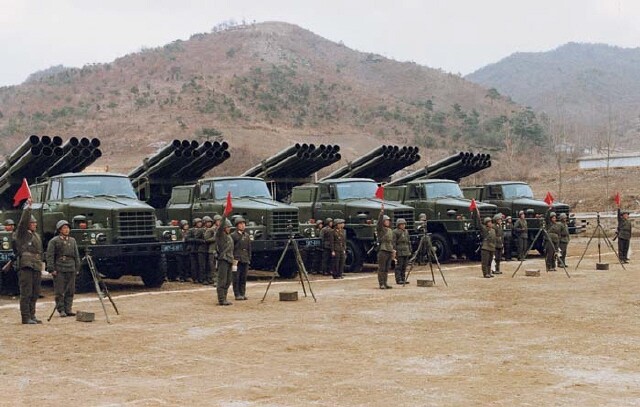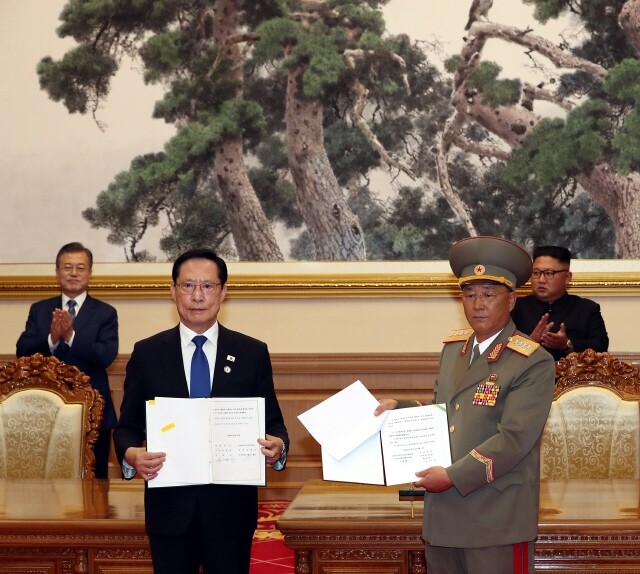hankyoreh
Links to other country sites 다른 나라 사이트 링크
Moving NK artillery out of range of Seoul suggested for reducing inter-Korean military tension

The rearward deployment of North Korean long-range artillery pointed at the Greater Seoul area is being suggested as a way of breaking through the current impasses in North Korea-US and inter-Korean relations in the wake of the North Korea-US summit in Hanoi.
“Arms control will need to play a leading role, if only to resolve the stalemate in negotiations on the North Korean nuclear issue,” said Bu Hyeong-wook, senior research fellow at the Korea Institute for Defense Analyses, in a presentation at a recent seminar in Seoul.
“An alternative approach from North Korea that could have a political impact is the rearward deployment of its long-range artillery on the western Korean Peninsula. By moving its 170mm and 240mm multiple rocket launchers that are aimed at Greater Seoul outside of firing range, it could have a dramatic impact in reducing fears of Seoul becoming a ‘sea of fire,’” Bu suggested.
More concretely, Bu proposed that North Korea move its long-range artillery in the west rearward by at least 40km – reducing the threat to the Greater Seoul area – while keeping its artillery in the east in its current place pending future discussions on its relocation. The idea is to act first to reduce the threat to Seoul and its environs, which are home to a large population and important facilities. Likening the pattern with artillery kept in place in the east and moved rearward in the west to the Taegeuk symbol, which appears on the Korean flags, Bu referred to the approach as the “Taegeuk positional adjustment model.”
Long-range artillery is considered along nuclear weapons and missiles as one of the three major categories of threats from North Korea. Cannons typically have a range in the area of 20km – which means that the long-range artillery has a farther reach. While Pyongyang is located 180km from the Military Demarcation Line (MDL), the Greater Seoul area is just 60km away. In other words, while North Korea could attack Seoul with cannons from near the MDL, the South could not do the same with Pyongyang.
Military authorities estimate that North Korea is currently targeting Seoul with six forward-deployed battalions with 170mm self-propelled artillery (mounted on armored vehicles similar to tanks), which have a range of 54km, and 330 240mm multiple rocket launchers (capable of simultaneously firing dozens of rockets), which have a range of 60km. In the case of an emergency situation where North Korea launches its long-range artillery at all once, shells could rain down over Seoul and as far as southern Gyeonggi Province. When inter-Korean relations have soured in the past, Pyongyang has warned that Seoul is “not far from the armistice line” and that it could end up a “sea of fire if a war occurs.”
For that reason, experts are viewing the rearward deployment of North Korea’s long-range artillery as potentially offering a historic turning point as well as a symbolic and practical step in reducing inter-Korean tensions and building trust.
“The Greater Seoul area is a place where a lot of international interchange takes place and has quite a number of US citizens staying there, so if North Korea were to voluntarily remove the long-range artillery threat to Greater Seoul, that would also represent a significant political achievement for US President Donald Trump [whose priority is protecting US citizens],” Bu suggested. As of 2016, there were 51,875 US nationals living in South Korea, many of them in the Greater Seoul area.

Seoul too close to MDL for S. Korean artillery to withdraw any further
The South Korean government has remained cautious about discussing the rearward deployment of North Korean artillery. If North Korea does move its long-range artillery back, it is also likely to demand the South Korea do the same with its K9 self-propelled howitzers, which have a range of 40km. At his National Assembly confirmation hearing last September, current Minister of National Defense Jeong Kyeong-doo said, “A principle of reciprocity would need to be applied if North Korean long-range artillery is relocated rearward.”
“It’s a good idea, but we would need to be cautious with the approach itself,” he suggested, noting that if the two sides were to move back their troops and firepower from the armistice line, this would raise issues due to Seoul being far closer to the line than Pyongyang.
Bu explained that the rearward deployment of North Korean artillery “would be contingent on North Korea not insisting that the South Korean military has to withdraw its firepower the same distance from the Demilitarized Zone as the North does” Noting that Seoul is too close to the MDL for the South Korean military to withdraw any farther, he said some concessions would be needed from Pyongyang.
Acknowledging objections that the long-range artillery relocation plan’s dependence on a major concession from the North may make it unrealistic, Bu suggested that the asymmetry of the artillery-based “sea of fire” threatened against Seoul by the North Korean military in the 1990s is less strategically effective now that the North has completed its nuclear weapon development, which translates into a possibility of Pyongyang conceding under certain political conditions. Specifically, he said North Korea could agree to it on the condition that the US accepts a comprehensive, step-by-step denuclearization plan; declares an end to the Korean War; relieves some of the current sanctions; establishes a liaison office in Pyongyang; and provisionally halts joint military exercises with South Korea.
Bu explained that an approach of both denuclearization and controls on conventional weapons in tandem would be needed on the Korean Peninsula. The relaxation in military tensions during the Cold War in Europe, which was mentioned as a model for arms control, followed a sequence in which the Intermediate-Range Nuclear Forces Treaty (INF) was signed, after which the Cold War came to an end and the Treaty on Conventional Armed Forces in Europe (CFE) was concluded. Bu said that while a method of resolving the nuclear issue first and addressing conventional weapon controls later was adopted in Europe, a different approach would be needed for the Korean Peninsula, as North Korea’s security concerns are too great to adopt a method proceeding from the conclusion of nuclear talks to political change and controls on conventional weaponry. Due to the risk of rising inter-Korean military tensions triggering an unintended conflict, he stressed the need to “let steam out of the pressure cooker” of excessive military confrontation between the two sides.
Inter-Korean military agreement culmination of years of negotiations
Referring to the inter-Korean military agreement reached on Sept. 19 of last year, Bu explained that South Korea was not the only side to make concessions, as the gist of the agreement was a framework for partially reducing the “surplus deterrence” sustained between South and North while keeping their mutual vulnerabilities in place. Some generals in the reserves have harshly denounced the military agreement as “disarmament to aid the enemy.”
Speaking at the same seminar, Kim Young-jun, a professor at the Korea National Defense University’s National Security Graduate School, said, “The Sept. 19 military agreement is not something new that a ‘progressive administration’ came up with based on radical left-wing idealist policies.”
“What the Sept. 19 agreement did was to flesh out developments that had been taking place consistently through the past administrations [of Presidents Lee Myung-bak and Park Geun-hye],” he said.
“The military agreement gave shape to things that had been building up over the years, ideas that we wanted to see embodied,” he explained.
Kim went on to say the agreement “is not meant to ‘benefit’ North Korea, nor does it weaken the South Korean military’s strength and combat capabilities or the South Korea-US alliance.”
“Among the existing strategic options vis-à-vis North Korea, the strategies of armed attack, sanctions, and pushing for a [regime] collapse in Pyongyang have only had the effect of boosting North Korea’s nuclear and missile capabilities and intensifying the crisis on the Korean Peninsula,” he said.
“The Sept. 19 military agreement is a key means of support for implementing a new larger strategy,” he added.
Some critics have denounced the Sept. 19 agreement for politicizing the national armed forces. Insisting that the military cannot adopt a position of concession, the Liberty Korea Party (LKP) and others have argued that while politicians may discuss peace, the military should not move first with steps such as eliminating guard posts. The critics have also maintained that the military should adopt a different position from the administration and Ministry of National Defense.
Kim said the military “should keep step with the strategy implemented by an elected administration.”
“Along with denuclearization, the inter-Korean military agreement could represent a key means for ushering peace to the Korean Peninsula,” he explained.
Nixon advocated arms control in Cold War as a Republican
Kim went on to say, “Nobody called the US military ‘pawns bowing before politics’ when the Pentagon pursued arms control with the Soviet Union [during the Cold War].”
“They represented a professional class that was supporting an elected government,” he said.
Kim also noted, “In the US, the administrations that have actively pursued arms control have all been Republican.”
“Was [Richard] Nixon denounced as a ‘leftist’ for pursuing arms control? From a universal perspective, we need to resolve misunderstandings regarding arms control.”
By Kwon Hyuk-chul, director of the Hankyoreh Peace Institute
Please direct comments or questions to [english@hani.co.kr]

Editorial・opinion
![[Column] Life on our Trisolaris [Column] Life on our Trisolaris](https://flexible.img.hani.co.kr/flexible/normal/500/300/imgdb/original/2024/0505/4817148682278544.jpg) [Column] Life on our Trisolaris
[Column] Life on our Trisolaris![[Editorial] Penalties for airing allegations against Korea’s first lady endanger free press [Editorial] Penalties for airing allegations against Korea’s first lady endanger free press](https://flexible.img.hani.co.kr/flexible/normal/500/300/imgdb/original/2024/0502/1817146398095106.jpg) [Editorial] Penalties for airing allegations against Korea’s first lady endanger free press
[Editorial] Penalties for airing allegations against Korea’s first lady endanger free press- [Editorial] Yoon must halt procurement of SM-3 interceptor missiles
- [Guest essay] Maybe Korea’s rapid population decline is an opportunity, not a crisis
- [Column] Can Yoon steer diplomacy with Russia, China back on track?
- [Column] Season 2 of special prosecutor probe may be coming to Korea soon
- [Column] Park Geun-hye déjà vu in Yoon Suk-yeol
- [Editorial] New weight of N. Korea’s nuclear threats makes dialogue all the more urgent
- [Guest essay] The real reason Korea’s new right wants to dub Rhee a founding father
- [Column] ‘Choson’: Is it time we start referring to N. Korea in its own terms?
Most viewed articles
- 1New sex-ed guidelines forbid teaching about homosexuality
- 2OECD upgrades Korea’s growth forecast from 2.2% to 2.6%
- 3[Column] Life on our Trisolaris
- 460% of young Koreans see no need to have kids after marriage
- 5Months and months of overdue wages are pushing migrant workers in Korea into debt
- 6[Guest essay] Maybe Korea’s rapid population decline is an opportunity, not a crisis
- 7Presidential office warns of veto in response to opposition passing special counsel probe act
- 8Is Japan about to snatch control of Line messenger from Korea’s Naver?
- 9Bills for Itaewon crush inquiry, special counsel probe into Marine’s death pass National Assembly
- 10Hybe-Ador dispute shines light on pervasive issues behind K-pop’s tidy facade